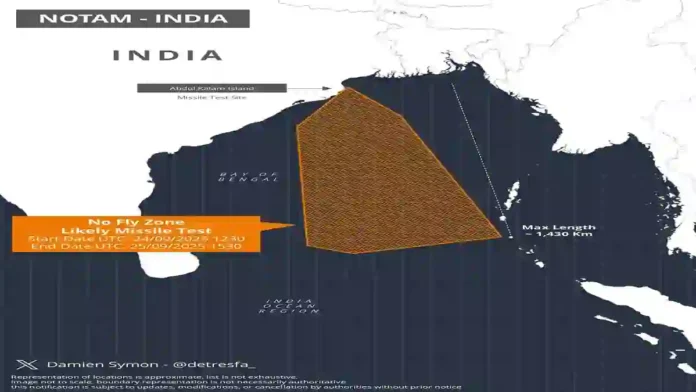India has issued a Notice to Airmen (NOTAM) indicating a likely missile test in the Bay of Bengal region, scheduled between September 24 and 25, 2025.
The designated test window reflects standard pre-launch protocols, alerting ships and aircraft about potential hazards in the region during the trial.
Read- Attempts To Break India-Russia Ties Destined To Fail: Moscow Amid Trump Pressure
This notification suggests the launch of a missile system with a maximum range below 1,500 km, pointing towards platforms such as the Agni-I, Agni Prime (Agni-P), or a trial of naval variants like the Dhanush or submarine-launched K-series systems.
The relatively modest range also indicates the possibility of developmental tests for newer precision-strike systems within India’s tactical and regional deterrence architecture.
In recent months, India has accelerated its missile testing tempo, underlining a pattern of validating new capabilities. In August 2025, India undertook multiple launches of nuclear-capable short-range Prithvi-II and Agni-I missiles, reaffirming readiness through routine user trials involving the Strategic Forces Command.
These short-range deterrent weapons are critical to filling the lower tier of the country’s nuclear triad deployment strategy. The latest NOTAM falls within this context of regular readiness exercises combined with new capability validation.
Separately, the Defence Research and Development Organisation (DRDO) and the Strategic Forces Command conducted a successful launch of the intermediate-range Agni-5 ballistic missile earlier this year.
That trial demonstrated a range of up to 5,000 km, effectively extending India’s strategic reach to cover much of continental Asia, including China’s eastern and northern regions, and parts of Europe. The Agni-5 validation marked a milestone for India’s operational deterrence, especially as the canisterized system offers quicker deployment, enhanced survivability, and longer storage capability.
The upcoming Bay of Bengal test differs significantly from Agni-5 in scope, as the stated range ceiling of under 1,500 km targets an entirely different mission set within the layered deterrence matrix.
Ballistic missiles in this class—whether land-based or possibly submarine-launched—are tailored for regional strike missions, rapid second-strike credibility, and improved survivability of launch platforms.
If the test involves the Agni-P, India would be advancing a next-generation system featuring composite motor casings, ring-laser gyroscope navigation, and improved accuracy compared to older Agni-I/II variants.
Conducting missile tests in the Bay of Bengal using launch sites such as Chandipur or Abdul Kalam Island is standard practice due to wide safety corridors and controlled maritime zones.
The upcoming trial continues India’s push for credible minimum deterrence and assured retaliation capabilities, while also modernizing tactical strike options to deter adversaries across both western and eastern fronts.
The pattern of successive launches also signals the maturing confidence of India’s defence establishment in expanding both operational deployment cycles and technology demonstration efforts.
Agencies




